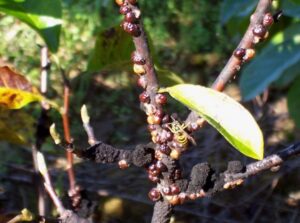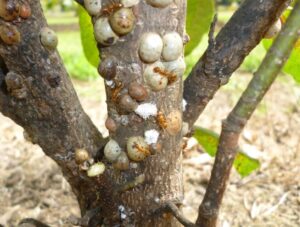WITCHES’ BROOMS: The development of witches’ brooms on woody plants and the resulting formation of abnormal growth can cause curiosity and concern to your clients. Typically, the new growth is distorted, and a proliferation of leaves or fruit/cones closely clumped together appears when apical dominance is lost. Witches’ Brooms are created on plants when the transfer of growth hormones is disrupted (perhaps caused from the introduction of a foreign substance). Insects (e.g., aphids), fungi, bacteria, viruses, phytoplasmas, and herbicides have all been implicated in causing the formation of witches’ brooms in many plant species.

Witches’ Brooms are plants having stunted foliage & short stem internodes. (Photo Credit: Steven K. Rettke, Rutgers Coop. Ext.)
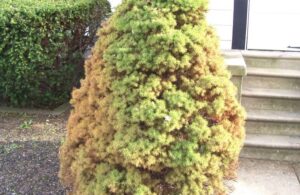
The Dwarf Alberta Spruce is a well-known landscape plant that is a type of Witches’ Broom. (Photo Credit: Steven K. Rettke, Rutgers Coop. Ext.)
The Dwarf Alberta Spruce photo is a well-known landscape plant that is a type of natural (non-toxic) genetically derived witches’ broom. Dwarf Alberta Spruce is the juvenile form of the White Spruce. Most landscapers know this plant for being exceptionally susceptible to spruce spider mites. Occasionally a stem can grow that has lost the genetic juvenile trait & the result is a full sized white spruce branch that will need to be pruned-out.
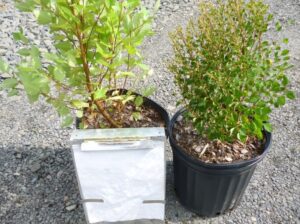
The river birch on the right may have been feed upon by potato leafhoppers when new leaves were first developing. (Photo Credit: Steven K. Rettke, Rutgers Coop. Ext.)
The photo of two adjacent containers shows two River Birch trees but having distinctly different leaf sizes. The cause is not totally clear, but there is suspicion the stunting of the smaller tree on the right was caused by the release of toxins from potato leafhopper feedings. Another idea is the stunted tree is infected with phytoplasmas. The Witches’ Broom appearance occurred primarily upon the upper canopy on the new emerging leaves. The stunted foliage never recovered from the spring feedings by the suspected potato leafhoppers. Note the difference in size of the non-affected normal sized River Birch leaves on the left.
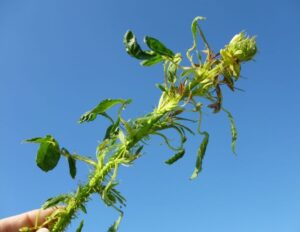
Close-up of an enlarged rose stem infected by Rose Rosette Disease. (Photo Credit: Steven K. Rettke, Rutgers Coop. Ext.)
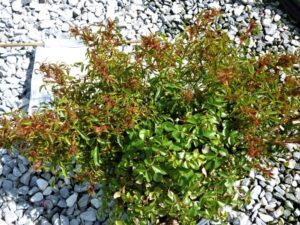
The Rose Rosette Disease is a virus vectored by eriophyid mites. (Photo Credit: Steven K. Rettke, Rutgers Coop. Ext.)
The couple of photos of Rose plants display symptoms from infections by the Rose Rosette Disease. This plant disease is a virus pathogen vectored by eriophyid mites. The virus causes a witches’ broom type growth. Note the excessive thorniness, strapped leaves & swollen stems.
It is interesting to note that sub-lethal doses of glyphosate (Round-Up) when applied on vegetation late in the season can cause witches’ brooms on new plant growth the following spring.
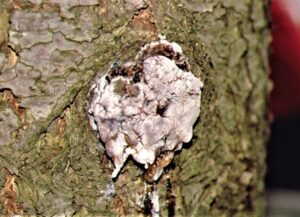
The actual Pitch Mass Borer larva was dug-out from under the pitch & can be seen at the bottom of mass. (Photo Credit: Steven K. Rettke, Rutgers Coop. Ext.)
PITCH MASS BORERS and LAC BALSUM WOUND DRESSING: Pitch Mass Borers are wood boring caterpillars. As adults they are called clearwing moths and are in the same family with lilac borers, rhododendron borers, peachtree borers, banded ash borers, dogwood borers, as well as others. Pitch mass borer adults are “on the wing” during the months of June and July and typically deposit eggs near wounds on several different pine and spruce species. The usual pine trees attacked include Austrian, Scotch, and eastern white. The common spruce trees attacked include Norway, white, and Colorado blue.

Copious amounts of pine resin can be produced after pruning cuts on conifers & can be further enhanced by the borers. (Photo Credit: Steven K. Rettkie, Rutgers Coop. Ext.)
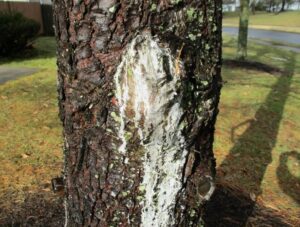
The pitch can potentially rain down on picnic tables, backyard decks or parked cars. (Photo Credit: Steven K. Rettke, Rutgers Coop. Ext.)
The pitch mass borer is primarily a nuisance in home landscapes or public park areas. Rarely do the borers create a plant health concern by girdling trunks or branches. They will take 2 to 3 years to mature and feed within the inner bark and outer sapwood. However, the shallow tunneling caterpillars do produce copious amounts of pitch. This pitch can potentially rain down on picnic tables, backyard decks or parked cars.
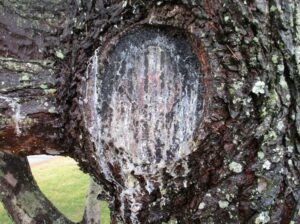
Pine branch pruning cuts create the open wound that invites the Pitch Mass Borer clear-winged moth to lay eggs. (Photo Credit: Steven K. Rettke, Rutgers Coop. Ext.)
The pitch mass borer, as well as all clearwing moths, requires a wound to successfully penetrate and bore into a tree. Therefore, pitch mass borer attacks will often increase after pruning wounds are made (proper pruning cuts included). Several years ago, some studies performed by Cornell University researchers unintentionally showed that pitch mass borer attacks could be reduced on recently pruned pines or spruces by applying a wound dressing. They applied a newer generation of wound dressing called Lac Balsum that was introduced from Europe a couple of decades ago. It has a flat gray color when applied over the wounds of fresh pruning cuts. The conifers receiving the wound dressing showed no evidence of pitch mass borer infestations after 2 years. Apparently the Lac Balsum acted as a protective barrier and/or did not attract egg deposition. On the other hand, 30% of the conifers not receiving the wound dressing showed evidence of pitch mass borer activity one or two years later (Note: proper experimental protocol was not followed in determining these results).
The goal of the Cornell research was to determine the health effects on conifers after applying the new Lac Balsum wound dressing. A few decades ago, the late Dr. Alex Shigo had made a strong case against the use of some tested wound dressings, demonstrating that they increased wood decay. Although the Lac Balsum wound dressing did not decrease wood decay in the pruning cut areas, the study also showed it did not increase wood decay either. Therefore, the Cornell research indicated that this new generation wound dressing could be safely used to improve the aesthetics after pruning without harming conifer trees.
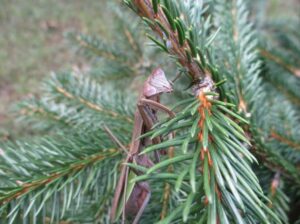
This mantid had no fear as it “eyeballs” the camera. Note the sharp barbs on the powerful front pair of legs. (Photo Credit: Steven K. Rettke, Rutgers Coop. Ext.)
PRAYING MANTIDS: Are They Valuable Landscape Predators? Contrary to popular belief, these well-known predators do not have a significant impact towards the suppression of any key landscape pests. Praying mantids are generalist predators and should not be promoted to clients as viable control agents in the landscape or garden. They are indiscriminate feeders and will consume both pest and beneficial insects, including honeybees, “ladybugs,” butterflies, and lacewings. Furthermore, they are cannibalistic and highly territorial. As these insects’ molt, grow and develop during the season, it is rare for them to maintain their numbers at densities high enough to contribute to major biological controls in the landscape.
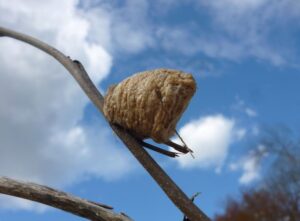
The overwintering Praying Mantid egg case is commonly observed in the landscape. The egg case looks & feels like styrofoam. Eggs will hatch in the spring. (Photo Credit: Steven K. Rettke, Rutgers Coop. Ext.)

Close to one hundred Praying Mantids hatched from egg case during spring. (Photo Credit: Steven K. Rettke, Rutgers Coop. Ext.)
An old urban myth, apparently sometimes promoted by elementary school children, is that state laws protect praying mantids. There have never been any official state laws protecting these insects anywhere in the country. However, the destruction of this insect is not being endorsed when observed. Their only crime is that they have incorrectly been awarded high status as valuable landscape predators.
ANTS & HONEYDEW PRODUCERS vs. PREDATORS: Various pests such as aphids, soft scales, mealybugs, and whiteflies are plant feeders that insert their piercing-sucking mouthparts into vascular tissue (phloem) to remove plant sap from leaves or stems. Since phloem sap is not nutrient rich in proteins, plant pests must withdraw large quantities to maintain growth and reproduction. As a result, to avoid blowing-up into “Macy’s Thanksgiving Day Balloon Floats” these insects must also expel copious amounts of unwanted waste called honeydew. The predigested honeydew still contains a lot of sugary carbohydrates and is valued by ants, wasps, bees, and other vespids as a food source. The honeydew is often easily observed as a clear, shiny, and sticky material on foliage. The honeydew usually darkens over time as a black sooty mold fungus grows on the liquid droppings.
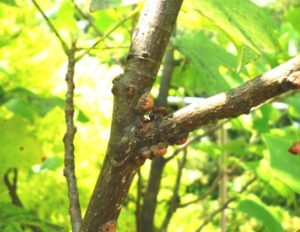
Ant feeds on pool of honeydew that was emitted by tuliptree soft scale above. (Photo Credit: Steven K. Rettke, Rutgers Coop. Ext.)

This lady beetle adult attempts to get beneath & feed on the exposed “under-belly” of the tuliptree soft scale. (Photo Credit: Steven K. Rettke, Rutgers Coop. Ext.)
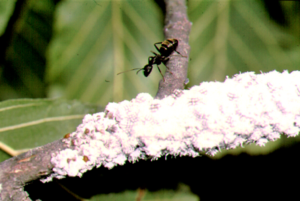
The ant acts as a sentry to guard the cluster of woolly alder aphids. (Photo Credit: Steven K. Rettke, Rutgers Coop. Ext.)
Numerous predators and parasitoids including lady beetles, lacewings, flower flies and wasp parasites typically attack and consume honeydew-producing pests. Carpenter ants and other colony ant species have waged vicious wars for “eons” against predators of honeydew producers. Like the sheep herder protecting his flock against wolves, certain ant species will expend a lot of energy and effort to protect honeydew producers and prevent effective biological control. As a result, to help restore the predator vs. prey balance in the landscape, it may be necessary for the pest manager to intervene and seek out ant colony locations to apply controls.
